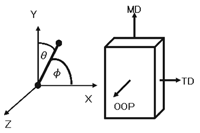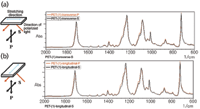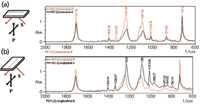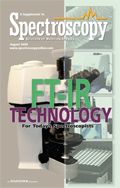Polarization Measurement of Film Using Single-Reflection FT-IR–ATR
Transmission methods are often affected by film thickness and can result in inaccuracies. Polarization measurement using attenuated total reflectance (ATR), a Fourier transform–infrared (FT-IR) technique, is offered as an alternate resource because it is not adversely affected by film thickness.
The long axes of the molecules of stretched polymers have a tendency to line up in the stretching direction, and the extent of this can be ascertained using polarization measurement. Film samples usually are analyzed with a transmission method using a polarizer. However, the transmission method is greatly affected by film thickness and can result in inaccuracies. Polarization measurement using attenuated total reflectance (ATR), a Fourier transform–infrared (FT-IR) technique, is offered as an alternate resource because it is not adversely affected by film thickness.
Polarization measurement uses linearly polarized light, which has an electric field that only oscillates in a certain direction. To create this linearly polarized light, a polarizer is required. Researchers commonly use polarizers created by incorporating a wire grid into a KRS-5 substrate.
The procedure of polarization measurement using the transmission method is as follows. First, background is measured with the polarizer at an angle of 0° (that is, with the electric field oriented in a perpendicular direction), and then the sample is measured with its stretching direction aligned with the vertical direction. At this time, the polarization direction and the direction of the stretching axis are parallel.
Then, the sample is rotated 90° so that the stretching direction is perpendicular to the polarization direction and measured. The ratio of the absorbances, A∥ and A⊥, of the spectra obtained in these two configurations (namely, with polarization parallel and perpendicular to the stretching direction) represents the dichroic ratio (R = A∥/A⊥).
FT-IR–ATR
With the transmission method, if the film thickness is too large, the peaks can become saturated, and measurement might not be possible. Attenuated total reflectance (ATR) has the advantage of not requiring consideration of film thickness.
With single-reflection ATR, because the prism is smaller than it is with multireflection ATR, it is easier to rotate the sample, and there is better adhesion so researchers can obtain spectra with good repeatability.
One of the features of ATR polarization measurement is that, in cases of film samples with two-axis symmetry as shown in Figure 1, the information can be obtained in relation to the orientation of the molecules with respect to the x, y, and z axes. In this diagram, the y axis represents the stretching direction; the x axis is the direction that is perpendicular to and in the same plane as the stretching direction; and the z axis is the direction that is perpendicular to the surface of the sample (the thickness direction).

Figure 1: Expressions of molecular orientation. In cases of two-axis symmetry: MD: Machine direction; TD: Transverse direction; and OOP: Out-of-plane direction.
Four types of measurements are required. The sample is first measured with its stretching direction aligned with the direction of light propagation, while being irradiated with parallel polarized light and perpendicular polarized light. Then the sample is rotated by 90° and the measurements are repeated with parallel polarized light and perpendicular polarized light.
Here, "parallel polarized light" refers to the linearly polarized light that has an electric field that is parallel to the plane containing the incident light and reflected light. "Perpendicular polarized light" refers to the linearly polarized light that has an electric field that lies in the plane perpendicular to the parallel polarized light. The evanescent wave generated at the reflection point by perpendicular polarized light has a vector in the x direction. The evanescent wave generated at the reflection point by parallel polarized light has vectors in the y and z directions (1) (Figure 2).

Figure 2: Directions of polarized light and evanescent wave.
The spectra obtained with the procedure described earlier reflect information about molecular vibration in the x, y, and z directions. Detailed methods for expressing the orientation for all three directions are referred to in the reference material (1).
Polarization Measurement for Stretched PET Film Using ATR
The spectra obtained here through the analysis of polyethylene terephthalate (PET) are presented using a Shimadzu IRPrestige-21 (at 4 cm–1 resolution) Fourier-transform infrared (FT-IR) spectrophotometer (Shimadzu, Columbia, Maryland) with a single-reflection ATR attachment (DuraSampllR II, Smiths Detection) using a diamond as an internal reflection element (IRE).
Figure 3 shows the results obtained by analyzing unstretched PET film in four modes. There are hardly any differences between the four spectra, indicating that there is no molecular orientation. Figure 4 shows the results obtained with the same PET film stretched by a factor of three.

Figure 3: Polarization measurement of unstretched PET film using single-reflection ATR.
For each stretching orientation, differences can be observed in the spectra obtained with parallel polarized light and perpendicular polarized light. For example, the peak in the neighborhood of 1340 cm–1 corresponds to the CH2 wagging vibration, and the mode in which the molecules oscillate in the direction of the long axes. In Figure 4a, this peak is high for parallel polarized light (P) and low for perpendicular polarized light (S). On the other hand, this is reversed in Figure 4b, indicating that the molecules are oriented in the stretching direction.

Figure 4: Polarization measurement of PET film stretched by a factor of three using single-reflection ATR.
The peak at 1410 cm–1 in Figure 4 was thought to correspond to the in-plane bending vibration of benzene rings in a nondichroic band. Figures 5a and 5b were obtained by normalizing this peak and generating differential spectra of the results for parallel polarized light and perpendicular polarized light, shown in Figures 4a and 4b. It can be seen that bands exhibiting infrared dichroism vary according to the orientation of the samples and the polarized light.

Figure 5: Differential spectra.
Everall and Bibby report that in experiments in which the stretching factor was varied in the range of 1.0 to 3.5, for larger stretching factors, the degree of orientation in the stretching direction was greater while the degrees of orientation in the transverse direction (that is, the direction in the plane of the film that is perpendicular to the stretching direction) and depth direction were smaller (1).
Conclusion
Polarization measurement using FT-IR–ATR is extremely effective for investigating the orientation of film surfaces. Single-reflection ATR using a diamond prism, however, does present some problems. For example, there are concerns about the effect that the localized application of large forces might have on the molecular orientation, and in the analysis of polymers with a high refractive index, the peaks in bands of strong absorbance can be lopsided. Therefore, when investigating orientation with polarization measurement using ATR, in consideration of these potential problems, it is necessary to select the optimum peaks that exhibit dichroism.
Seiji Takeuchi is with Shimadzu Corporation, Analytical Applications Dept., Kyoto, Japan.
References
(1) N.J. Everall and A. Bibby, Appl. Spectrosc. 51, 1083 (1997).

AI Shakes Up Spectroscopy as New Tools Reveal the Secret Life of Molecules
April 14th 2025A leading-edge review led by researchers at Oak Ridge National Laboratory and MIT explores how artificial intelligence is revolutionizing the study of molecular vibrations and phonon dynamics. From infrared and Raman spectroscopy to neutron and X-ray scattering, AI is transforming how scientists interpret vibrational spectra and predict material behaviors.
Real-Time Battery Health Tracking Using Fiber-Optic Sensors
April 9th 2025A new study by researchers from Palo Alto Research Center (PARC, a Xerox Company) and LG Chem Power presents a novel method for real-time battery monitoring using embedded fiber-optic sensors. This approach enhances state-of-charge (SOC) and state-of-health (SOH) estimations, potentially improving the efficiency and lifespan of lithium-ion batteries in electric vehicles (xEVs).
New Study Provides Insights into Chiral Smectic Phases
March 31st 2025Researchers from the Institute of Nuclear Physics Polish Academy of Sciences have unveiled new insights into the molecular arrangement of the 7HH6 compound’s smectic phases using X-ray diffraction (XRD) and infrared (IR) spectroscopy.